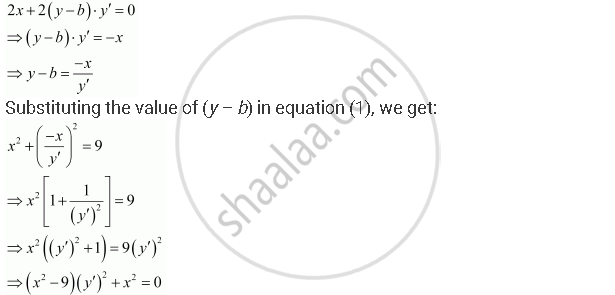Advertisements
Advertisements
प्रश्न
Form the differential equation of the family of circles having centre on y-axis and radius 3 units.
उत्तर
Let the centre of the circle on y-axis be (0, b).
The differential equation of the family of circles with centre at (0, b) and radius 3 is as follows:
`x^2+(y - b)^2 = 3^2`
Differentiating equation (1) with respect to x, we get:

This is the required differential equation.
APPEARS IN
संबंधित प्रश्न
Form the differential equation of the family of circles touching the y-axis at the origin.
Form the differential equation of the family of circles in the first quadrant which touch the coordinate axes.
Form the differential equation of the family of curves represented by y2 = (x − c)3.
Form the differential equation from the following primitive where constants are arbitrary:
y = cx + 2c2 + c3
Form the differential equation from the following primitive where constants are arbitrary:
xy = a2
Form the differential equation from the following primitive where constants are arbitrary:
y = ax2 + bx + c
Find the differential equation of the family of curves y = Ae2x + Be−2x, where A and B are arbitrary constants.
Form the differential equation corresponding to y2 = a (b − x2) by eliminating a and b.
Form the differential equation corresponding to y2 − 2ay + x2 = a2 by eliminating a.
Form the differential equation of the family of curves represented by the equation (a being the parameter):
(2x − a)2 − y2 = a2
Represent the following families of curves by forming the corresponding differential equations (a, b being parameters):
y2 = 4ax
Represent the following families of curves by forming the corresponding differential equations (a, b being parameters):
(x − a)2 − y2 = 1
Represent the following families of curves by forming the corresponding differential equations (a, b being parameters):
Represent the following families of curves by forming the corresponding differential equations (a, b being parameters):
y2 = 4a (x − b)
Show that y = bex + ce2x is a solution of the differential equation, \[\frac{d^2 y}{d x^2} - 3\frac{dy}{dx} + 2y = 0\]
For the differential equation xy \[\frac{dy}{dx}\] = (x + 2) (y + 2). Find the solution curve passing through the point (1, −1).
Find one-parameter families of solution curves of the following differential equation:-
\[x\frac{dy}{dx} - y = \left( x + 1 \right) e^{- x}\]
Find one-parameter families of solution curves of the following differential equation:-
\[x\frac{dy}{dx} + y = x^4\]
Find one-parameter families of solution curves of the following differential equation:-
\[\left( x \log x \right)\frac{dy}{dx} + y = \log x\]
Find one-parameter families of solution curves of the following differential equation:-
\[\frac{dy}{dx} \cos^2 x = \tan x - y\]
Find one-parameter families of solution curves of the following differential equation:-
\[x\frac{dy}{dx} + 2y = x^2 \log x\]
Write the order of the differential equation representing the family of curves y = ax + a3.
The differential equation which represents the family of curves y = eCx is
The family of curves in which the sub tangent at any point of a curve is double the abscissae, is given by
Form the differential equation representing the family of curves y = mx, where m is an arbitrary constant.
Form the differential equation of the family of ellipses having foci on y-axis and centre at the origin.
Form the differential equation representing the family of curves `y2 = m(a2 - x2) by eliminating the arbitrary constants 'm' and 'a'.
Find the differential equation of the family of curves y = Ae2x + B.e–2x.
Find the differential equation of the family of lines through the origin.
Find the equation of a curve whose tangent at any point on it, different from origin, has slope `y + y/x`.
Find the equation of a curve passing through the point (1, 1) if the perpendicular distance of the origin from the normal at any point P(x, y) of the curve is equal to the distance of P from the x-axis.
Form the differential equation of all circles which pass through origin and whose centres lie on y-axis.
Find the equation of the curve through the point (1, 0) if the slope of the tangent to the curve at any point (x, y) is `(y - 1)/(x^2 + x)`
Find the equation of a curve passing through origin if the slope of the tangent to the curve at any point (x, y) is equal to the square of the difference of the abcissa and ordinate of the point.
Find the equation of a curve passing through the point (1, 1). If the tangent drawn at any point P(x, y) on the curve meets the co-ordinate axes at A and B such that P is the mid-point of AB.
The differential equation representing the family of circles x2 + (y – a)2 = a2 will be of order two.
Differential equation representing the family of curves y = ex (Acosx + Bsinx) is `("d"^2y)/("d"x^2) - 2 ("d"y)/("d"x) + 2y` = 0
The area above the x-axis and under the curve `y = sqrt(1/x - 1)` for `1/2 ≤ x ≤ 1` is:
